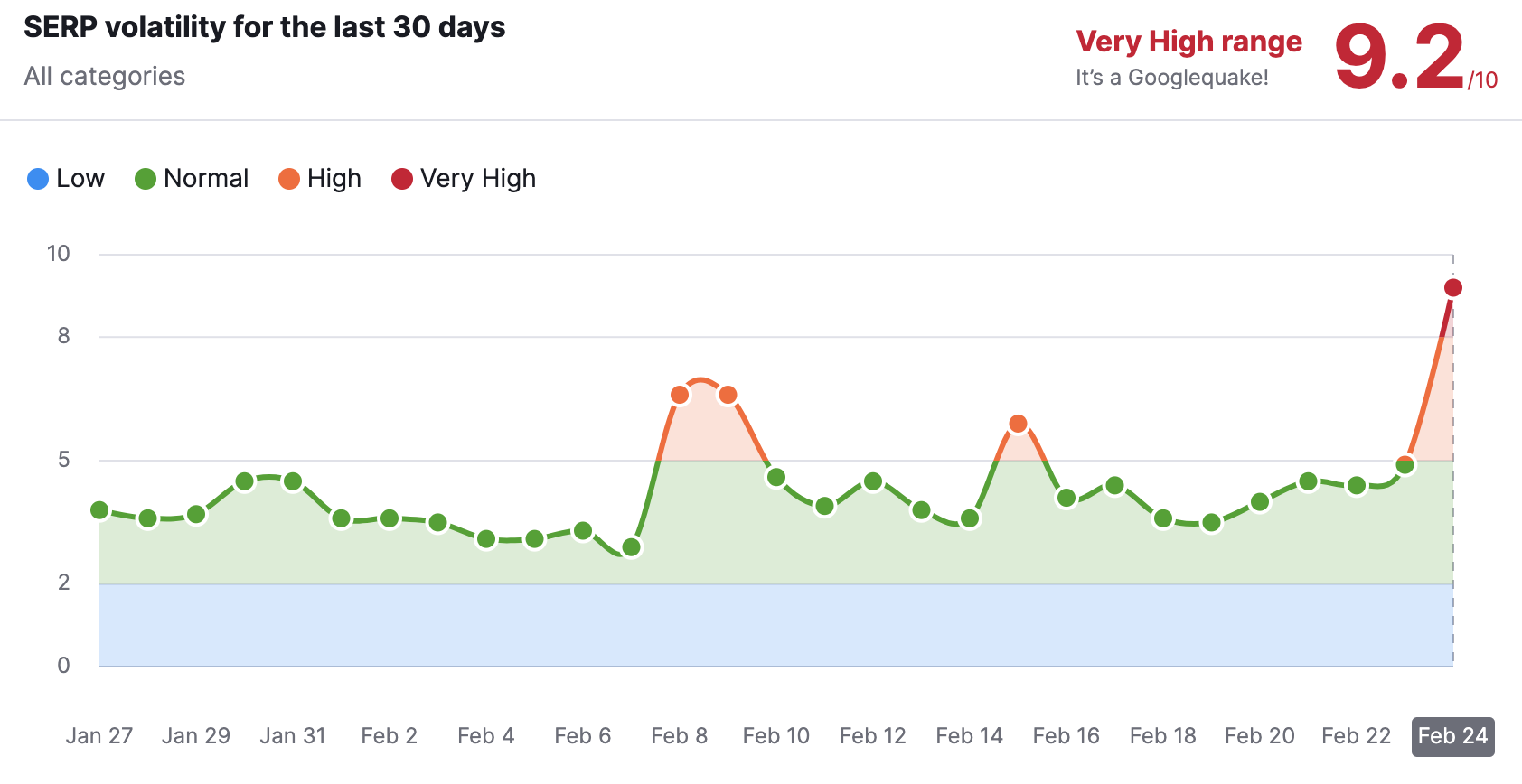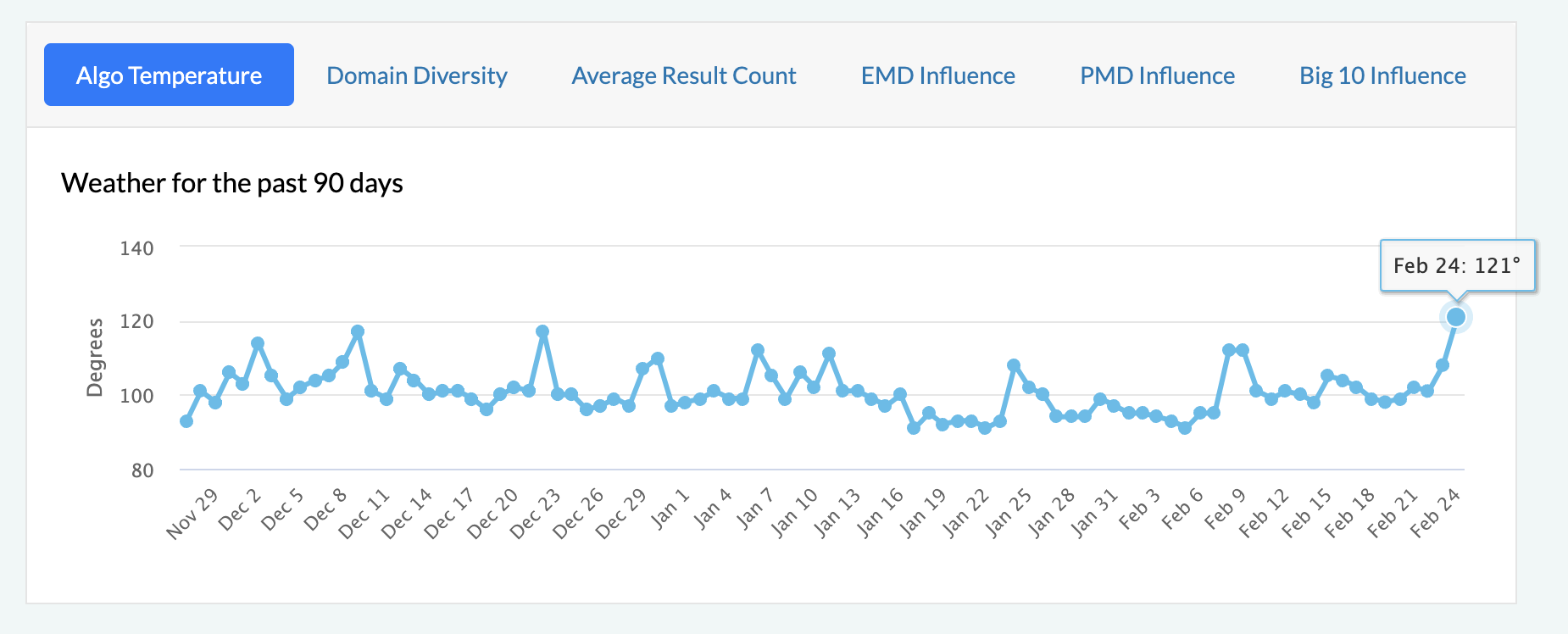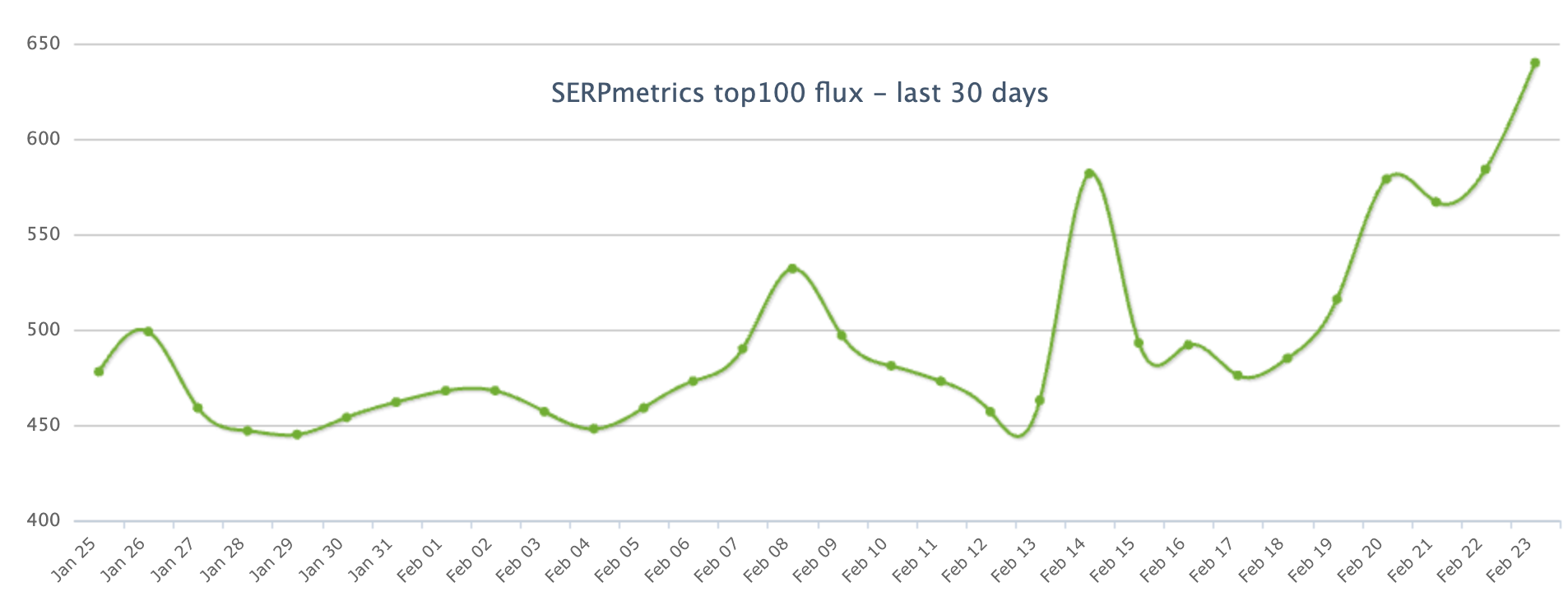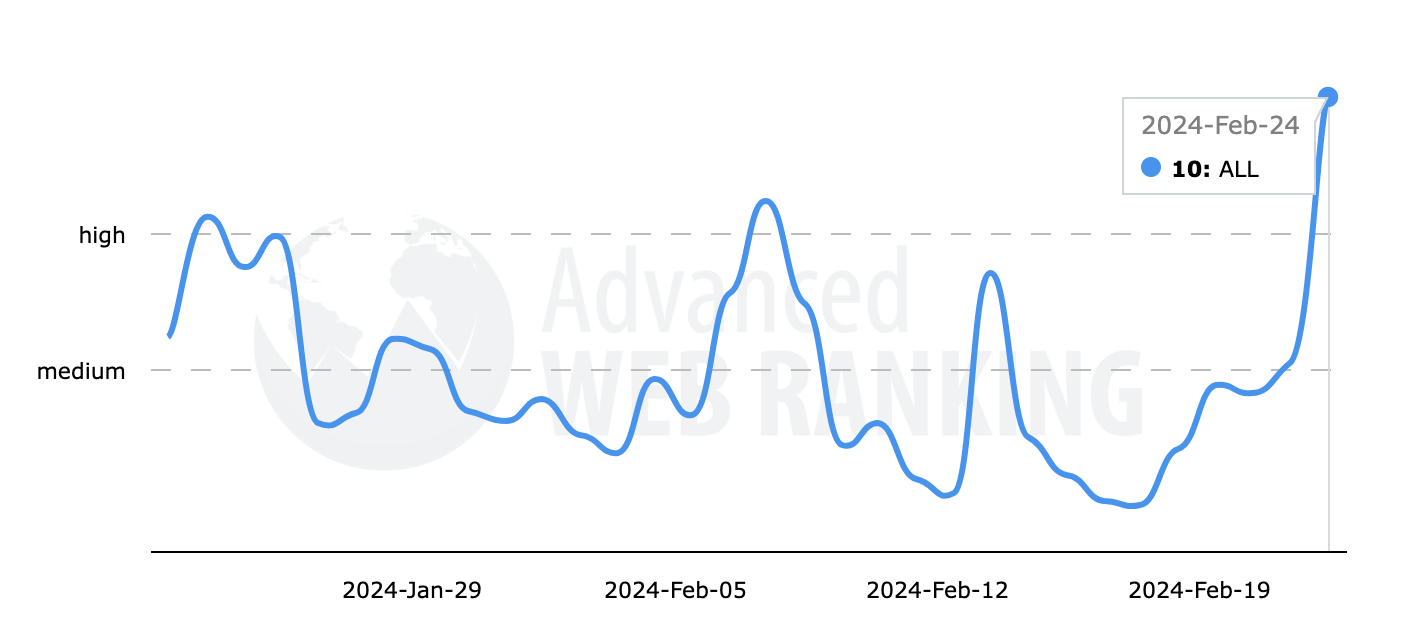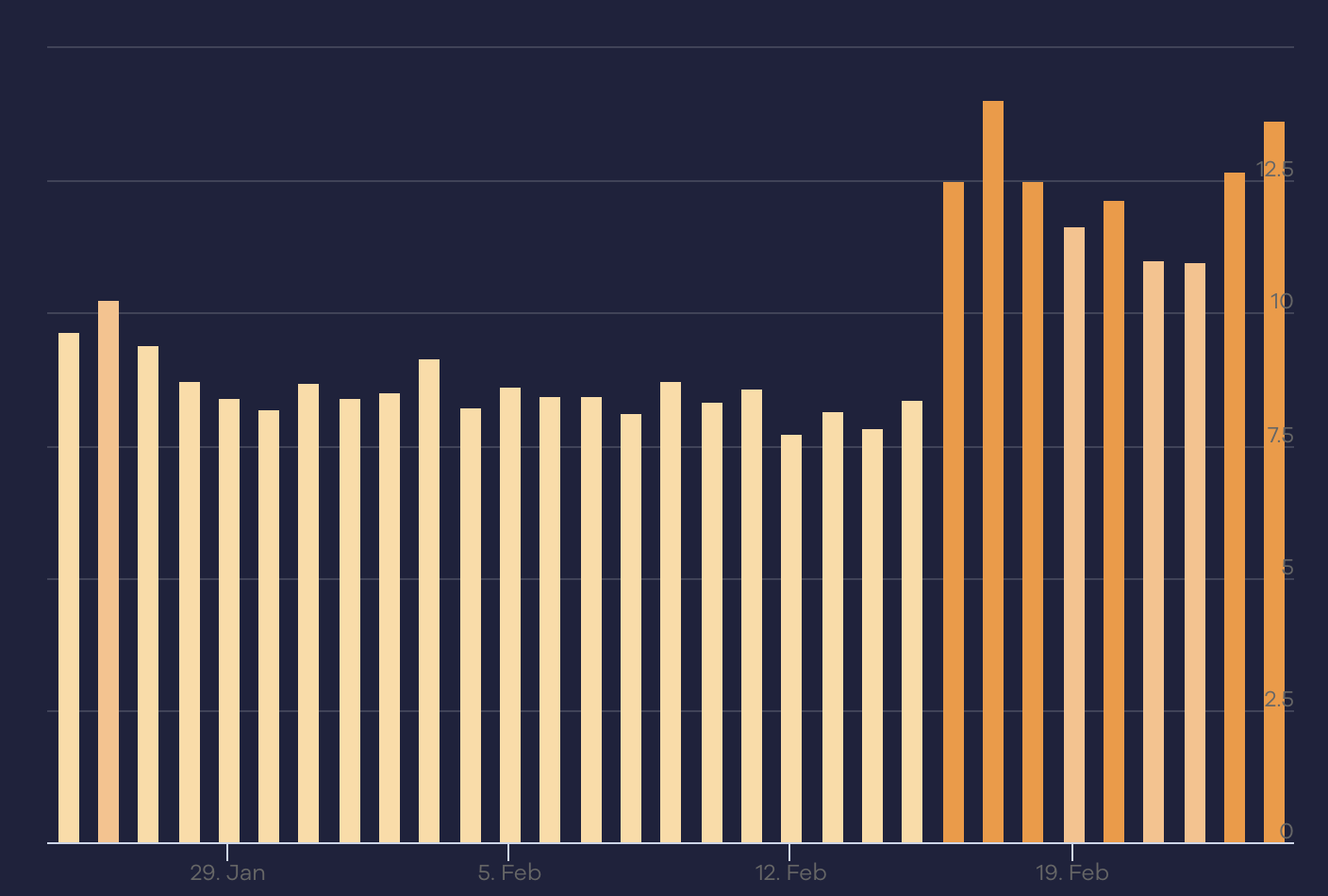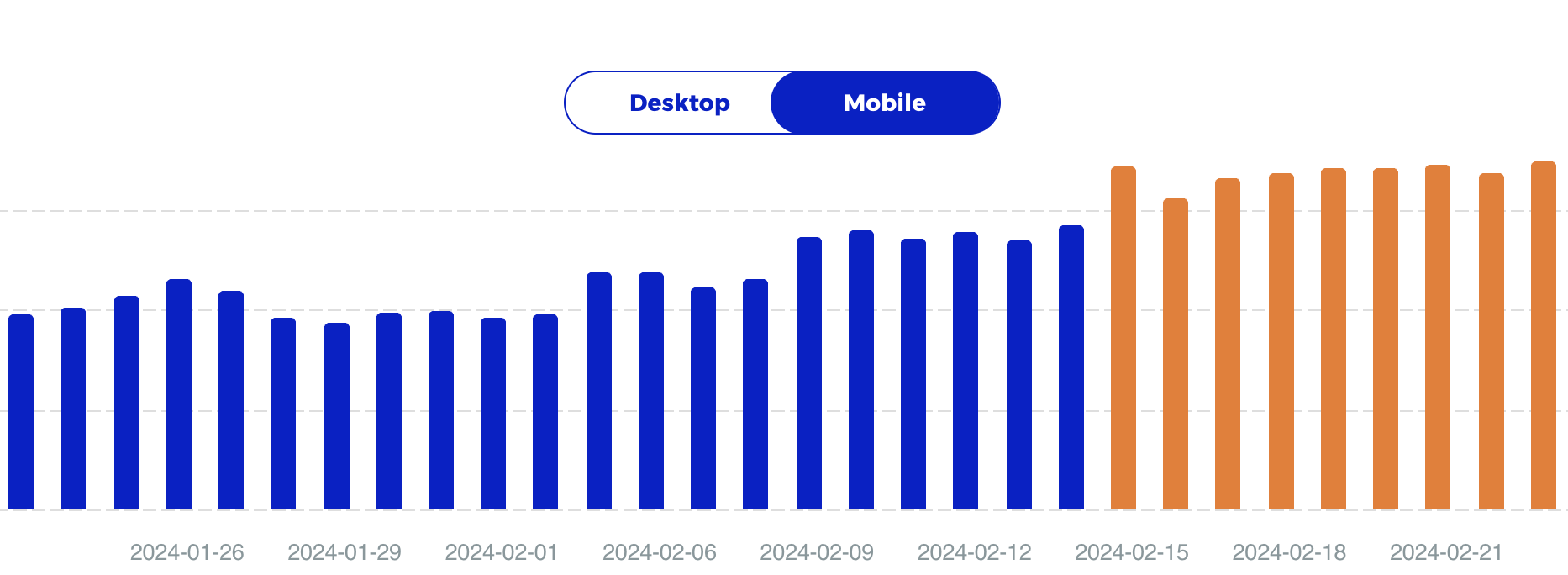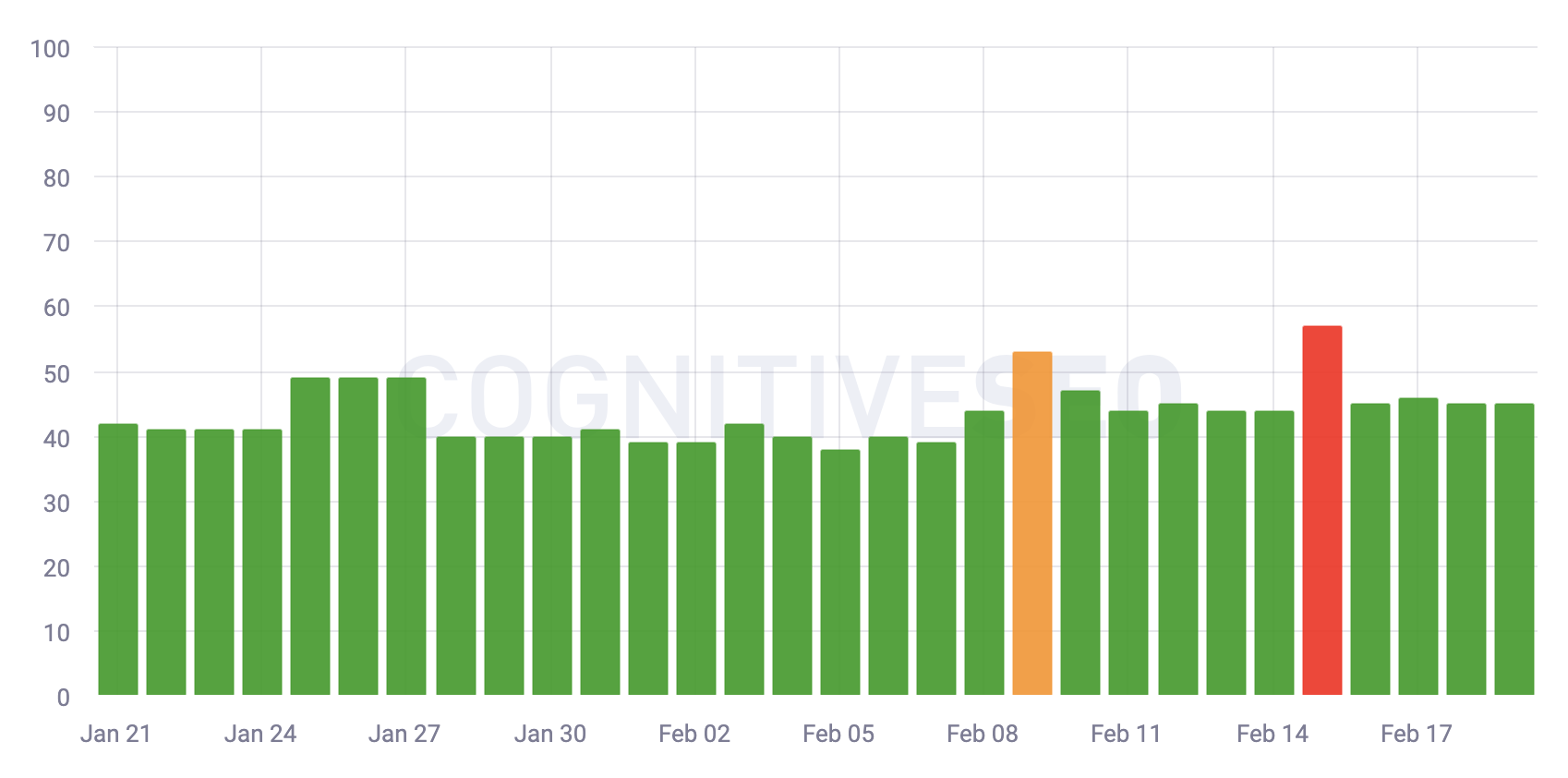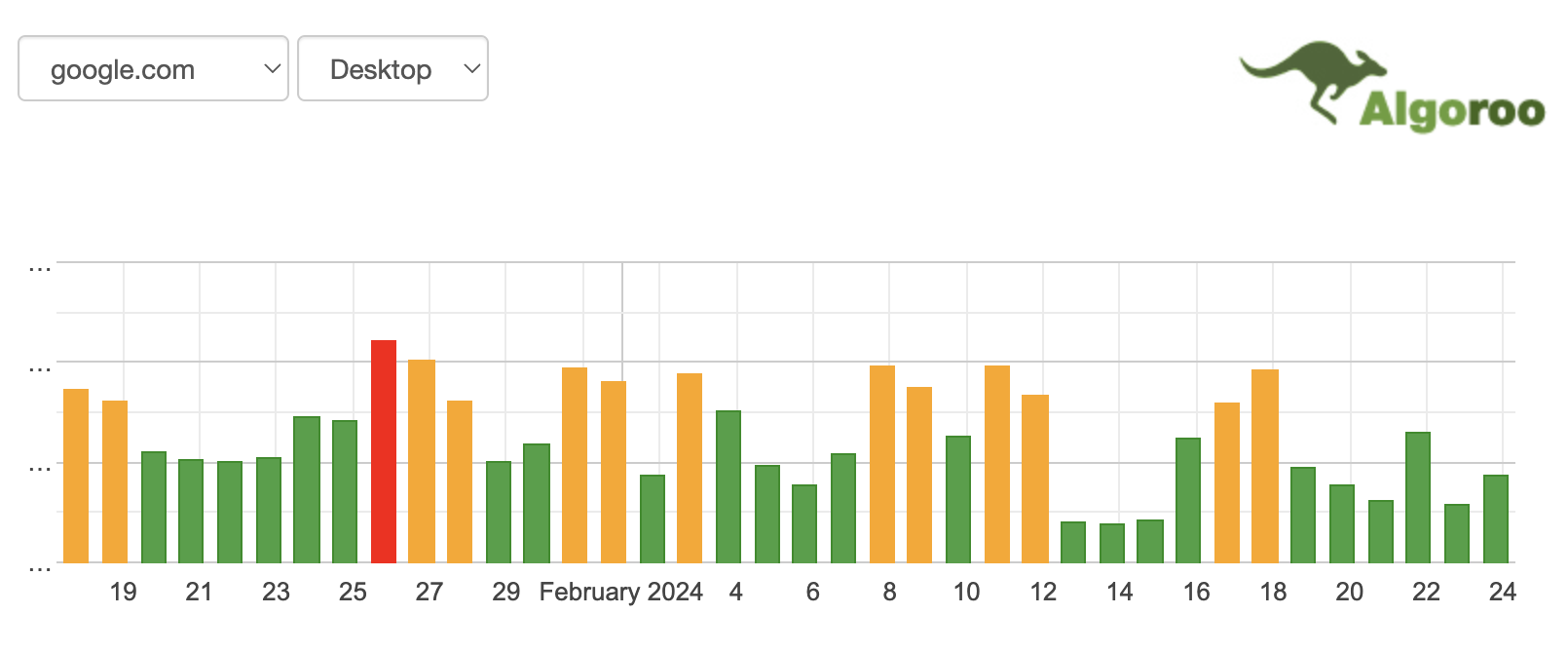OTHER
What Should You Look For When Choosing a Shopify Theme

A recent study found that 70 percent of Americans are shopping online more than ever.
E-commerce is booming, and there’s never been a better time to start an online store. One of the best platforms to launch your e-commerce store is Shopify.
Why do so many people love Shopify? In part due to its:
- affordability
- ease of use
- scalability
- security
One stand-out reason many e-commerce store owners love Shopify is the flexibility it offers through Shopify themes. With thousands of paid and free themes available, you can create a unique e-commerce store that offers your customers a positive user experience (UX).
That could be why over a million businesses use Shopify to build their e-commerce stores.
What Are Shopify Themes?
Shopify themes are a template that determines the way your website looks and feels to customers who visit your store. Different themes offer different styles and layouts. Also, each theme offers a different UX, depending on how it is designed.
Design plays a massive role in the way your store attracts, engages, and converts. That’s why the Shopify theme you choose is critical to your business’ success.
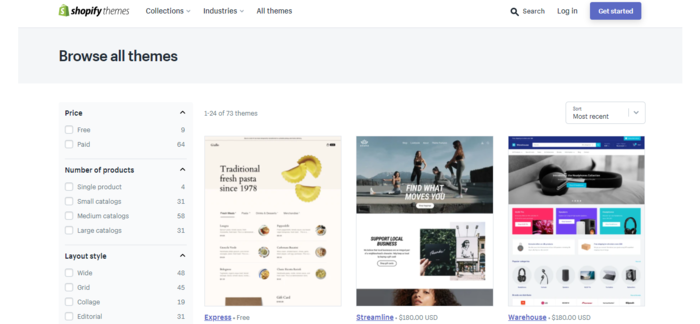
In e-commerce, your theme of choice must reflect your industry and niche. For example, if you’re in the health and wellness niche, you’ll want a theme that looks professional and feels reassuring.
If, on the other hand, you’re into electronics, you’ll want a theme that’s sleek and energetic.
Will Changing Themes Break Your Store?
One fear that most store owners have when changing themes is that it will break their Shopify store.
That’s not true.
Changing your Shopify theme (or editing your current one) doesn’t affect your content or other parts of your account.
So feel free to play around with your theme settings or even getting a new Shopify theme that you fancy. Your e-commerce store won’t break, and you’ll rarely have any downtime if you do it right.
Why Your Shopify Theme Matters
Now that you know what a Shopify theme is, let’s briefly look at why your theme choice matters so much.
Helps Project Your Brand Personality
One of your most important assets as a business is your brand.
And no—branding doesn’t just mean logo.
An essential aspect of branding is your brand personality. Brand personality is a set of human characteristics that can be attributed to a brand. For example,
- sophistication
- excitement
- fun-loving
- sincerity
- ruggedness
Your theme plays a critical role in helping you project these characteristics. As a result, your Shopify store will attract customers who share and love your personality.
Determines Your Website’s UX
Your theme is a crucial aspect of your store’s design because it determines your website’s UX. That’s because your theme determines essential facets of your e-commerce store like navigation, layout, color schemes and aesthetics, and more.
Your theme determines the experience your customers will have as they navigate your store, consume your content, and search for products. If the experience is positive, they’re likely to keep coming back. A negative experience, on the other hand, leads to high bounce rates.
7 Tips to Pick the Perfect Shopify Theme for Your Store
Ready to shop around for the perfect Shopify theme for your store?
Here are a few tips to help you find the perfect one.
1. Decide on Your Budget
Shopify stores come at varying price points. That’s why your first step to choosing your Shopify theme is to determine how much you’re willing to spend on a theme.
Examples of factors that impact the theme’s price include:
- The developer: More experienced and well-known developers tend to charge more for their themes.
- Flexibility: The level of customization of your theme impacts its price. For example, if it has drag-and-drop functionality, you can expect to pay a bit more.
- Level of functionality. Some themes are limited in functionality, while others allow you to turn your e-commerce store into anything you want. Those with extra bells and whistles, like forms or SEO features, tend to cost more.
Like everything else in life, you get what you pay for when it comes to Shopify themes. Make sure to read the fine print and understand what features and functionality a theme has before buying.
2. Prioritize Themes on the Shopify Theme Store
Shopify theme developers are a dime a dozen. You can get a theme for your Shopify store from many theme marketplaces.
However, I highly recommend choosing from the themes on Shopify’s theme store.
One of the main reasons is that Shopify carefully screens all themes submitted, so you can be sure to get a quality, secure theme.
Another reason to prioritize themes on Shopify’s theme store is that you’ll be assured of regular updates and world-class support.
3. List the Main Features and Functions You Want
The key to finding the perfect Shopify theme for your store is to consider the main features and functionality you want for your store.
Do you want a slide-out cart drawer?
Is a video player a priority?
Do you need forms, landing pages, or a blog?
Finding a theme with most of the features you’re looking for will help you cut down on development costs. When you find a theme with one of the most important features you’re looking for but not the others, move on. The key is finding one that has most of the themes you want. You can always have a developer add the missing feature(s).
To find features included in a theme, check out the theme preview page. However, because not every feature may be listed there, you may want to play around with the theme demo.
You can also use the live store examples to help you get a feel of all the features of a theme you’re considering.
4. Consider Your Niche
Most themes are developed for specific industry types. When picking a Shopify theme, you must make sure it was designed for your niche. For example, an e-commerce store that sells various electronics and accessories can’t easily use a theme designed for fine art pieces.
That’s because the electronic store needs a theme that can handle many categories and advanced search capabilities. The art store, on the other hand, doesn’t need as much advanced functionality.
As you hunt for a Shopify theme, make sure to filter your top picks by niche. Fortunately, the Shopify theme store makes it easy to search for themes by niche and number of products.
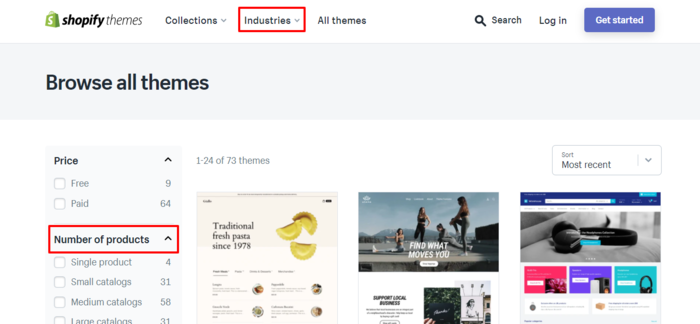
5. Design and Aesthetics
Global e-retail sales is a whopping $4.2 trillion industry.
To get a piece of the global e-commerce action, you must attract and retain customers to your e-commerce store. That’s the key to growing a successful Shopify e-commerce store.
Attracting customers can be achieved through search engine optimization (SEO) best practices, like keyword research.
But retaining customers on your site is all about your design and aesthetics. The right Shopify theme makes design simple by providing:
- an attractive storefront
- color palettes that match your brand
- clean and easy-to-understand user interface (UI)
A well-designed Shopify store will not only look amazing, but it will also encourage more conversions.
6. Favor Lightweight Mobile-Friendly Shopify Themes
Website speed is crucial to online success, as it can impact search rankings, conversions, and bounce rate. To offer visitors the fast page speed they want, you need a fast, lightweight theme.
Lightweight themes focus more on performance and tend to avoid busy elements like animations, fancy scrollers, and other unnecessary features that increase the size of the file.
Another advantage of lightweight themes is they’re designed to be simple. Their main goal is to help customers navigate around your store and perform the action they came to do.
To deliver a fast, easy-to-use site, you’ll want to choose a mobile-friendly theme.
7. Optimized Checkout
Studies show that the average e-commerce store losses about 75 percent of its sales to cart abandonment. The same studies show that one of the leading reasons for cart abandonment is a complicated checkout process.
That’s why you must make sure the Shopify theme you choose offers an optimized checkout experience.
The best Shopify themes offer a fast and intuitive checkout process, well-designed add-to-cart buttons, and an easy way to check the total cost.
Making the checkout process easy should be a priority, so ensure the theme you choose makes this as easy as possible.
3 Examples of Great Shopify Themes
Now you know how to pick a suitable Shopify theme for your store. Before you run off to find yours, let’s look at a few great Shopify themes and discuss what makes them stand out from the rest. You might just find your perfect match right here!
Brooklyn
Brooklyn is one of the top free Shopify themes out there.

The theme is designed for the apparel and accessories niche. Because of that, it focuses on a brand image by enabling you to show off your inventory with stunning visuals. Some notable features include:
- A Slide Out Cart: Helps customers easily add items to their cart without leaving the current page.
- Home Page Slideshow: Use the top of your homepage to showcase multiple products or brand images.
- Video integration: Grab attention, tell your story, and showcase your best products in action by featuring a YouTube or Vimeo video on your page.
If you’re bootstrapping your way to e-commerce success in the apparel niche, Brooklyn is a the Shopify theme to help you get there. (Did I mention it was free?)
Icon
Looking for a lightweight and easy-to-use Shopify theme that will help you set up a stunning store quickly?
The $180 Icon Shopify theme could be what you’re looking for.

One of Icon’s greatest strengths is that it’s built to power omnichannel marketing campaigns. That’s thanks to seamless social media integration and a blog to power your content marketing. Other features include:
- Sticky Navigation: Keeps your menus fixed to the top of your page as customers scroll down.
- Product Quick View: Customers can view product details in a popup, so they don’t have to leave the current page
- Multi-column menu: Helps you feature product images in a large, multi-column drop-down menu.
As the name suggests, Icon is one Shopify theme that will help you build an iconic e-commerce store and generate a lot of revenue.
Expression
Have a large inventory of products?
Then you need a Shopify theme that can help you display them all beautifully. Your theme should also make it easy for your customers to find what they’re looking for.
Expression is one of the best Shopify themes that can help you do that and more.

That’s because some of the theme’s prominent features include drop-down menu bars, advanced search functionality, and a dynamic slideshow.
Other notable features you can expect are:
- Versatile Sidebar Area: You can use your sidebar to display blog posts, images, advertisements, and more.
- Product Image Rollover: Hovering over products reveals different product images, giving customers a clearer picture before they buy.
- Grid-Style Layout: This allows you to feature multiple products or promotions in a grid-style layout throughout your store.
Expression will set you back $180, but it’s worth the investment as it helps you create an e-commerce store with attention-grabbing visuals. It’s also designed to make your promotions stand out, thereby encouraging more conversions.
Conclusion
The e-commerce space is fast growing as more entrepreneurs are launching e-commerce stores. One of the most trusted platforms to launch a store is Shopify. As you design your store, pay careful attention to the Shopify theme you use.
Remember, your theme affects your store’s:
- user experience
- aesthetics
- performance
All three are factors that have a huge impact on your conversion rates.
Which Shopify themes have you had experience with? What do you like about it?
See How My Agency Can Drive Massive Amounts of Traffic to Your Website
- SEO – unlock massive amounts of SEO traffic. See real results.
- Content Marketing – our team creates epic content that will get shared, get links, and attract traffic.
- Paid Media – effective paid strategies with clear ROI.
OTHER
Why Malia Obama Received Major Criticism Over A Secret Facebook Page Dissing Trump

Given the divisive nature of both the Obama and Trump administrations, it’s unsurprising that reactions to Malia Obama’s alleged secret Facebook account would be emotional. Many online users were quick to jump to former President Donald Trump’s defense, with one user writing: “Dear Malia: Do you really think that anyone cares whether you and/or your family likes your father’s successor? We’re all trying to forget you and your family.”
Others pointed out the double standard held by those who condemn Trump for hateful rhetoric but praise people like Malia who speak out against her father’s successor in what they believe to be hateful rhetoric. Some users seemed bent on criticizing Malia simply because they don’t like her or her father, proving that the eldest Obama daughter couldn’t win for losing regarding the public’s perception of her or her online presence.
The secret Facebook situation is not all that dissimilar to critics who went after Malia for her professional name at the 2024 Sundance Film Festival. In this instance, people ironically accused Malia of using her family’s name to get into the competitive festival while also condemning her for opting not to use her surname, going by Malia Ann instead.
OTHER
Best Practices for Data Center Decommissioning and IT Asset Disposition

Data center decommissioning is a complicated process that requires careful planning and experienced professionals.
If you’re considering shutting down or moving your data center, here are some best practices to keep in mind:
Decommissioning a Data Center is More than Just Taking Down Physical Equipment

Decommissioning a data center is more than just taking down physical equipment. It involves properly disposing of data center assets, including servers and other IT assets that can contain sensitive information. The process also requires a team with the right skills and experience to ensure that all data has been properly wiped from storage media before they’re disposed of.
Data Centers Can be Decommissioned in Phases, Which Allows For More Flexibility
When you begin your data center decommissioning process, it’s important to understand that it’s not an event. Instead, it’s a process that takes place over time and in phases. This flexibility allows you to adapt as circumstances change and make adjustments based on your unique situation. For example:
-
You may start by shutting down parts of the facility (or all) while keeping others running until they are no longer needed or cost-effective to keep running.
-
When you’re ready for full shutdown, there could be some equipment still in use at other locations within the company (such as remote offices). These can be moved back into storage until needed again.
Data Center Decommissioning is Subject to Compliance Guidelines
Data center decommissioning is subject to compliance guidelines. Compliance guidelines may change, but they are always in place to ensure that your organization is following industry standards and best practices.
-
Local, state and federal regulations: You should check local ordinances regarding the disposal of any hazardous materials that were used in your data center (such as lead-based paint), as well as any other applicable laws related to environmental impact or safety issues. If you’re unsure about how these might affect your plans for a decommissioned facility, consult an attorney who specializes in this area of law before proceeding with any activities related to IT asset disposition or building demolition.
-
Industry standards: There are many industry associations dedicated specifically toward helping businesses stay compliant with legal requirements when moving forward with projects such as data center decommissioning.
-
Internal policies & procedures: Make sure everyone on staff understands how important it is not just from a regulatory standpoint but also from an ethical one; nobody wants their name associated with anything inappropriate!
Companies Should Consider Safety and Security During the Decommissioning Process
Data center decommissioning is a complex process that involves several steps. Companies need to consider the risks associated with each step of the process, and they should have a plan in place to mitigate these risks. The first step of data center decommissioning is identifying all assets and determining which ones will be reused or repurposed. At this point, you should also determine how long it will take for each asset to be repurposed or recycled so that you can estimate how much money it will cost for this part of your project (this can be done through an estimate based on previous experience).
The second step involves removing any hazardous materials from electronic equipment before it’s sent off site for recycling; this includes chemicals used in manufacturing processes like lead-free solder paste adhesives used on circuit boards made from tin-based alloys containing up 80% pure tin ingots stamped out into flat sheets called “pucks”. Once these chemicals have been removed from whatever device needs them taken off their surfaces then those devices can safely go through any other necessary processes such as grinding away excess plastic housing material using high pressure water jets until only its bare frame remains intact without any cracks where moisture might collect inside later causing corrosion damage over time due too much moisture exposure.
With Proper Planning and an Effective Team, You’ll Help Protect Your Company’s Future
Data center decommissioning is a complex process that should be handled by a team of experts with extensive experience in the field. With proper planning, you can ensure a smooth transition from your current data center environment to the next one.
The first step toward a successful data center decommissioning project is to create a plan for removing hardware and software assets from the building, as well as documenting how these assets were originally installed in the facility. This will allow you or another team member who may inherit some of these assets later on down the line to easily find out where they need to go when it’s time for them to be moved again (or disposed).
Use Professional Data Center Decommissioning Companies
In order to ensure that you get the most out of your data center decommissioning project, it’s important to use a professional data center decommissioning company. A professional data center decommissioning company has experience with IT asset disposition and can help you avoid mistakes in the process. They also have the tools and expertise needed to efficiently perform all aspects of your project, from pre-planning through finalizing documentation.
Proper Planning Will Help Minimize the Risks of Data Center Decommissioning

Proper planning is the key to success when it comes to the data center decommissioning process. It’s important that you don’t wait until the last minute and rush through this process, as it can lead to mistakes and wasted time. Proper planning will help minimize any risks associated with shutting down or moving a data center, keeping your company safe from harm and ensuring that all necessary steps are taken before shutdown takes place.
To Sum Up
The key to a successful ITAD program is planning ahead. The best way to avoid unexpected costs and delays is to plan your ITAD project carefully before you start. The best practices described in this article will help you understand what it takes to decommission an entire data center or other large facility, as well as how to dispose of their assets in an environmentally responsible manner.
OTHER
Massive Volatility Reported – Google Search Ranking Algorithm Update

I am seeing some massive volatility being reported today after seeing a spike in chatter within the SEO community on Friday. I have not seen the third-party Google tracking tools show this much volatility in a long time. I will say the tracking tools are way more heated than the chatter I am seeing, so something might be off here.
Again, I saw some initial chatter from within the SEO forums and on this site starting on Friday. I decided not to cover it on Friday because the chatter was not at the levels that would warrant me posting something. Plus, while some of the tools started to show a lift in volatility, most of the tools did not yet.
To be clear, Google has not confirmed any update is officially going on.
Well, that changed today, and the tools are all superheated today.
Google Tracking Tools:
Let’s start with what the tools are showing:
So most of these tools are incredibly heated, signaling that they are showing massive changes in the search result positions in the past couple of days.
SEO Chatter
Here is some of the chatter from various comments on this site and on WebmasterWorld since Friday:
Speaking of, is anyone seeing some major shuffling going on in the SERPs today? It’s a Friday so of course Google is playing around again.
Something is going on.
Pages are still randomly dropping out of the index for 8-36h at a time. Extremely annoying.
Speaking of, is anyone seeing some major shuffling going on in the SERPs today? It’s a Friday so of course Google is playing around again
In SerpRobot I’m seeing a steady increase in positions in February, for UK desktop and mobile, reaching almost the ranks from the end of Sep 2023. Ahrefs shows a slight increase in overall keywords and ranks.
In the real world, nothing seems to happen.
yep, traffic has nearly come to a stop. But exactly the same situation happened to us last Friday as well.
USA traffic continues to be whacked…starting -70% today.
In my case, US traffic is almost zero (15 % from 80%) and the rest is kind of the same I guess. Traffic has dropped from 4K a day to barely scrapping 1K now. But a lot is just bots since payment-wise, the real traffic seems to be about 400-500. And … that’s how a 90% reduction looks like.
Something is happening now. Google algo is going crazy again. Is anyone else noticing?
Since every Saturday at 12 noon the Google traffic completely disappears until Sunday, everything looks normal to me.
This update looks like a weird one and no, Google has not confirmed any update is going on.
What are you all noticing?
Forum discussion at WebmasterWorld.
-

 SEO7 days ago
SEO7 days agoGoogle Limits News Links In California Over Proposed ‘Link Tax’ Law
-

 SEARCHENGINES6 days ago
SEARCHENGINES6 days agoGoogle Core Update Volatility, Helpful Content Update Gone, Dangerous Google Search Results & Google Ads Confusion
-
SEARCHENGINES7 days ago
Daily Search Forum Recap: April 12, 2024
-

 SEO6 days ago
SEO6 days ago10 Paid Search & PPC Planning Best Practices
-

 MARKETING6 days ago
MARKETING6 days ago2 Ways to Take Back the Power in Your Business: Part 2
-

 SEARCHENGINES5 days ago
SEARCHENGINES5 days agoWeekend Google Core Ranking Volatility
-

 MARKETING5 days ago
MARKETING5 days ago5 Psychological Tactics to Write Better Emails
-

 PPC7 days ago
PPC7 days agoCritical Display Error in Brand Safety Metrics On Twitter/X Corrected













